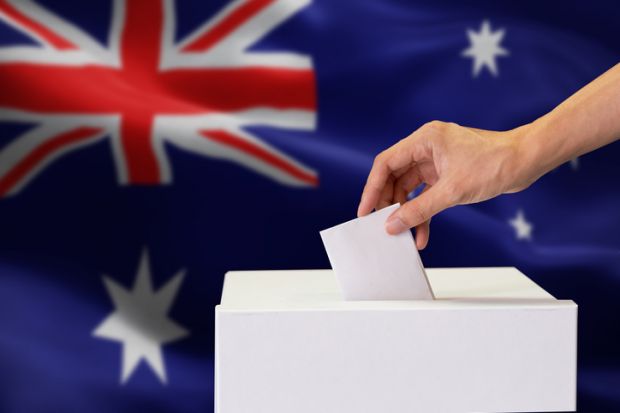Locally focused sweeteners may be the only goodies universities can expect from Australia’s general election this weekend, following a campaign that has steered clear of the systemic issues confronting higher education.
Universities have attracted few mentions so far in the six-week campaign, with neither major political party producing a policy to deal with arguably the sector’s biggest problem – a huge shortfall in funding to support research, after the pandemic triggered a downturn in universities’ lucrative international enrolments.
And neither the Labor opposition nor the Liberal-led governing coalition has offered a convincing solution to a looming shortage of university places, with an early-2000s baby bubble expected to more than double the annual growth in school leaver numbers in coming years.
Labor has pledged to fund up to 20,000 extra university places over two years, while the coalition says that its Job-ready Graduates reforms have created up to 30,000 additional places. Critics say that these claims only add up because of inadequate subsidies for degrees in law, business and particularly the arts – a structural problem neither party has addressed.
And while Labor has proposed an “accord” on higher education, this falls well short of its commitments before the 2019 election, which included a comprehensive review of post-secondary education and the restoration of the demand-driven system for domestic undergraduate places.
Meanwhile, many of the coalition’s big-money commitments to universities during the campaign – five grants of A$50 million (£28 million) each, to establish hubs for the commercialisation of research in critical minerals, defence, renewable energy, space manufacturing and food and beverages – represent the fulfilment of promises made months earlier.
The government pledged to fund four of these “Trailblazer University” hubs last November, adding a fifth in the March budget.
Genuinely new promises of money have been targeted at the local level, with a handful of fortunate universities benefiting from their locations in closely contested electorates – and the major parties’ reluctance to be trumped by each other.
The coalition has pledged A$50 million for a new Central Queensland University (CQU) campus in Cairns, matching a promise from Labor in November. Cairns lies mostly in the electorate of Leichhardt, considered a bellwether seat normally won by whichever party goes on to form government.
The Coalition has also matched a Labor commitment of A$9 million towards an electric vehicle training centre in CQU’s Mackay campus, in another closely watched electorate.
For its part, Labor has matched coalition commitments of A$100 million towards a forestry innovation institute at the University of Tasmania’s Launceston campus – in Bass, the most marginal government-held electorate in the country – and A$77 million towards a comprehensive cancer research and treatment centre near Boothby, another marginal Liberal seat.
Labor has also promised to spend A$147 million to boost capacity and lift standards in teacher training courses, days after the coalition committed A$70 million towards measures to improve teacher training.
Universities want more fundamental issues addressed. The Group of Eight network has reportedly lobbied the “teal” independents – a loose alliance of more than 20 mostly female contestants who are considered legitimate chances of claiming half a dozen prized coalition seats – to highlight “issues plaguing the sector”, with teaching subsidy inequities topping the list.




